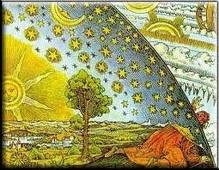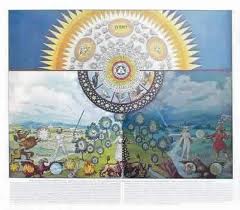Psychosomatics
Psychosomatics: a holistic approach

In the seventeenth century we are witnessing a scientific revolution through the philosophy of Descartes, Newton and Galileo. Descartes (1596-1626) maintains the separation between mind, or res cogitans, and body or res extensa, which the body, being only subject, it is measurable as any other object in nature.
With Newton (1642-1727) will lay down the axioms of classical physics, how the concept of absolute space and time, the cause-effect relationship between events, the concept of matter represented by the sum of simple elements.
on these funds is based on the experimental method proposed by Galileo (1564-1642), which states may be observable only what is measurable and that leads to the formulation of mathematical hypotheses, and every experiment that demonstrates the validity of the hypothesis is repeated over and over again and give the same result.
These principles are taken from the philosophical system of positivism in 800 and also applied to medical knowledge, creating a model of medicine that remains unchanged until the twentieth century. This is a reductionist and mechanistic model that considers the human body a measurable res extensa, which works the same way as a complex machine, but broken down into simpler elements, namely the organs and systems, which constitute the "gear".
The disease is a malfunction of the machine body, so the patient does not count in the psychological aspect, which is res cogitans, but the symptom that brings.
Health coincides with the absence of disease and treatment becomes almost a standard protocol, so the healing process does not belong to the patient, but it is totally in the hands of the doctor. At the end of the 800
but faces a new school of thought that begins to have a global look man, which no longer makes sense to separate cogitans res extensa and res. This is the first form of psychosomatic, still imbued with determinism, because the daughter of positivism, in fact, it attempts to scientifically prove the union between mind and body, without, however, still assert their identity.

But early dell'900 Jung provides the key to the definition of psychosomatic medicine, offering a symbolic vision man, who admits the presence of seemingly opposite aspects contrary to rational thought, but that vision is not opposed to science, but accompanying it.
The psychosomatic approach in a symbolic claims that everything that happens in nature, and then in humans, is regulated by complex balances so that the relation of cause and effect is insufficient to explain them.
Jung introduced the concept of synchronicity , namely the coincidence of two or more events that have a similar meaning, but which are not related in a causal relationship, but by harmonies from "sympathy". He then says that in nature the relationship between events is often synchronic.
Jung introduced the concept of synchronicity , namely the coincidence of two or more events that have a similar meaning, but which are not related in a causal relationship, but by harmonies from "sympathy". He then says that in nature the relationship between events is often synchronic.
The event sync is favored by lowering the mental level, that of rational consciousness, a particular interest, strong emotions, and boredom, distrust and disinterest are an obstacle. The elements of space and time have no influence, because in itself does not exist, but are placed in the conscience.
same time, in the same period in which Jung presents his ideas, quantum physics is showing how the causal laws hitherto considered valid, are applicable only to macroscopic quantities, and are inappropriate considering the matter at the subatomic level.
The laboratory experiments are also drop the validity of the concept of repeatability of the experiment and neutrality of the experimenter, as if between the scientist and the object of observation was created a relationship, a partnership, reminiscent of the synchronicity that Jung speaks.
In particular, a microscopic look at the matter, the nature of the subject escapes because it gets aired. The concept of "what" the brick, which is the primary subject is elusive and ambivalent: is both particle and wave.
In particular, a microscopic look at the matter, the nature of the subject escapes because it gets aired. The concept of "what" the brick, which is the primary subject is elusive and ambivalent: is both particle and wave.
Since the matter in the most intimate is the same in all beings, the human nature has this dual role and is both matter and energy . In other words we can say that man is a synchronous event of psyche and body, the final decree identity. A concept
introduced by the fundamental psychosomatic medicine is that of organ size, which can be defined as the provision that everyone has to express a symptom with one or more organs. But it is still more: it is a way of being in the world, that analogy is much like an organ or tissue because they express a certain kind of psychological dimension.
E 'disease which is expressed by the "language" of a certain body, the psychic dimension that manifests itself physically.
E 'is the archetype that somatization. In this vision
E 'disease which is expressed by the "language" of a certain body, the psychic dimension that manifests itself physically.
E 'is the archetype that somatization. In this vision
psychosomatic illness becomes a central event in the history of the individual because it recounts the life of the person. The disease affects an organ, but involves the entire psychosomatic synchronously.
addition, if the disease goes by when living beings appeared and was not eliminated by evolution, must have meaning, it must be somehow "useful" to humans, to grow and to redesign a new balance in his life, because life is a dynamic equilibrium, and cyclical.
Healing does not mean eliminating the symptoms to return to the previous illness, but is to accompany the individual to the new equilibrium .
The best possible health so it is not the well-being absolute, the sense of absence of disease, but the alternative health / disease because it involves transformation and does not alter the natural cycles of life.
The best possible health so it is not the well-being absolute, the sense of absence of disease, but the alternative health / disease because it involves transformation and does not alter the natural cycles of life.
disease, in conclusion, it is an opportunity for the individual. Although it seems paradoxical statement, must also be capable of getting sick.

0 comments:
Post a Comment